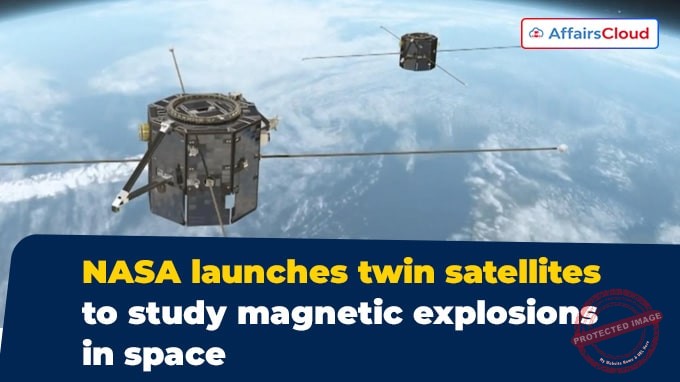
In July 2025, National Aeronautics and Space Administration (NASA) launched its new mission named ‘Tandem Reconnection and Cusp Electrodynamics Reconnaissance Satellites (TRACERS)’, which comprises a pair of twin satellites that will study how Earth’s magnetic shield (magnetosphere), protects our planet from the Sun called solar wind.
- The spacecraft TRACERS was lifted off aboard SpaceX’s Falcon 9 rocket from Space Launch Complex 4 East at Vandenberg Space Force Base in California, the United States of America (USA).
About TRACER Mission:
Supervision of Mission: The mission is led by David Miles at the University of Iowa (UI) with support from the Southwest Research Institute in San Antonio, Texas.
Designed: The spacecraft for the mission was built by Boeing Company (formerly known as Millennium Space Systems).
Function of twin satellites: The twin satellites will fly in tandem, just 10 seconds (s) apart and will collect over 3,000 measurements during their one-year mission.
- Once in full operation, TRACERS will study how the solar winds from the Sun interact with magnetic field of Earth.
Polar Cusp: The satellites will orbit through an open region in Earth’s magnetic field near the North Pole, called the ‘Polar Cusp’, where particles from the Sun enter into Earth’s atmosphere.
- The mission will examine how these charged particles move and energy travels through near-Earth space.
Other NASA Missions Launched:
Apart from TRACERS, the Falcon 9 rocket carried and successfully deployed 3 more NASA satellites namely, Athena EPIC (Economical Payload Integration Cost) Small Sat, Polylingual Experimental Terminal (PExT) technology demonstration and Relativistic Electron Atmospheric Loss (REAL) Cub Sat.
Athena EPIC: The mission is led by NASA’s Langley Research Centre based in Hampton, Virginia, USA, in collaboration with National Atmospheric Administration; USA Space Force and NovaWurks.
- It is designed to show an innovative, configurable way to deploy remote-sensing instruments into orbit faster and in more affordable manner.
PExT demonstration: It is managed by NASA’s Space Communications and Navigation (SCaN) program in collaboration with Johns Hopkins Applied Physics Laboratory.
- It will demonstrate new technology that empowers mission to roam between communication networks in space for instance mobile phones roam between providers on Earth.
REAL CubSat: It is led by Dartmouth College based in Hanover, New Hampshire.
- It will investigate how high-energy particles within the bands of radiation that surround Earth are naturally scattered into atmosphere, and will further help in the development of methods for removing these damaging particles to protect satellites.
About National Aeronautics and Space Administration (NASA):
Acting Administrator- Sean Patrick Duffy
Headquarters- Washington DC, the United States of America (USA)
Established- 1958




